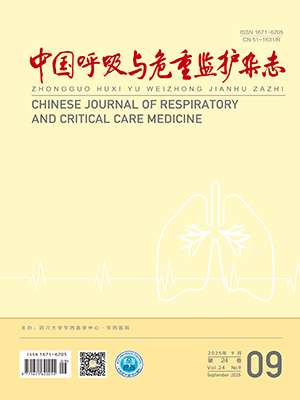| 1. |
Jia L, Zhao J, Yang C, et al. Severe pneumonia caused by coinfection with influenza virus followed by methicillin-resistant Staphylococcus aureus induces higher mortality in mice. Front Immunol, 2018, 9(2): 3189-3195.
|
| 2. |
Casas-Aparicio GA, Leon-Rodriguez I, Hernandez-Zenteno RJ, et al. Aggressive fluid accumulation is associated with acute kidney injury and mortality in a cohort of patients with severe pneumonia caused by influenza A H1N1 virus. PLoS One, 2018, 13(2): 2592-2598.
|
| 3. |
Quah J, Jiang B, Tan PC, et al. Impact of microbial aetiology on mortality in severe community-acquired pneumonia. BMC Infect Dis, 2018, 18(1): 451-455.
|
| 4. |
John KG, John TJ, Taljaard JJ, et al. The outcome of severe varicella pneumonia with respiratory failure admitted to the intensive care unit for mechanical ventilation. Eur Respir J, 2018, 52(1): 6774-6779.
|
| 5. |
朱明华, 毕艳华, 刘华, 等. 呼吸机管路内细菌污染与呼吸机相关性肺炎的相关性研究. 中华医院感染学杂志, 2017, 27(10): 2233-2236.
|
| 6. |
王帅, 安里占. 呼吸机相关性肺炎的感染途径及病原菌分布调查分析. 中国医学装备, 2017, 14(1): 35-38.
|
| 7. |
Andre C. Kalil, Mark L. Metersky, et al Management of adults with hospital-acquired and ventilator-associated pneumonia: 2016 Clinical Practice Guidelines by the Infectious Diseases Society of America and the American Thoracic Society. Clin Infect Dis, 2016, 63(5): e61-e111.
|
| 8. |
裴兴华, 于海明, 吴艳红, 等. APACHEⅡ评分与老年重症肺炎需有创机械通气患者谵妄发生的关系. 中华危重病急救医学, 2017, 29(9): 821-824.
|
| 9. |
Sakamoto Y, Yamauchi Y, Yasunaga H, et al. Guidelines-concordant empiric antimicrobial therapy and mortality in patients with severe community-acquired pneumonia requiring mechanical ventilation. Respir Investig, 2017, 55(1): 39-44.
|
| 10. |
Pleil JD, Wallace MAG. New breath related topics: sample collection for exhaled breath condensate and aerosol, development of real-time medical alerts, measurement of artificial atmospheres, and analysis of legalized cannabis product. J Breath Res, 2018, 12(3): 39001-39009.
|
| 11. |
Winters BR, Pleil JD, Angrish MM, et al. Standardization of the collection of exhaled breath condensate and exhaled breath aerosol using a feedback regulated sampling device. J Breath Res, 2017, 11(4): 107-112.
|
| 12. |
邱淑花, 黄毓东, 刘云阁, 等. 呼吸机管路内细菌污染与呼吸机相关性肺炎的相关性. 深圳中西医结合杂志, 2017, 27(21): 21-22.
|
| 13. |
闫卫彬, 卢立国, 孙婷婷, 等. 呼吸机相关性肺炎患者呼吸机管道冷凝液培养的临床研究. 现代中西医结合杂志, 2013, 22(8): 869-871.
|
| 14. |
谭杏飞, 陈瀚熙, 蓝惠兰, 等. 密闭式呼吸机湿化管道系统细菌培养分析. 护理学杂志, 2015, 30(15): 92-94.
|
| 15. |
刘亚楠. 呼吸机管道中冷凝水被污染时段及影响因素分析[D]. 锦州医科大学, 2016.
|
| 16. |
李娟, 田鹏, 张雪霜. 儿童呼吸机相关性肺炎与呼吸机管路细菌定植的关系. 临床肺科杂志, 2018, 23(1): 104-106, 110.
|
| 17. |
Zhao D, Zuo Y, Wang Z, et al. Characterize carbapenem-resistant Klebsiella pneumoniae isolates for nosocomial pneumonia and their Gram-negative bacteria neighbors in the respiratory tract. Mol Biol Rep, 2019, 12(3): 8984-8988.
|
| 18. |
Watkins RR, Van Duin D. Current trends in the treatment of pneumonia due to multidrug-resistant Gram-negative bacteria. F1000Res, 2019, 8(2): 884-889.
|
| 19. |
Feng DY, Zhou YQ, Zou XL, et al. Factors influencing mortality in hospital-acquired pneumonia caused by Gram-negative bacteria in China. J Infect Public Health, 2019, 12(12): 7843-7851.
|
| 20. |
Cilloniz C, Dominedo C, Torres A. Multidrug resistant Gram-negative bacteria in community-acquired pneumonia. Crit Care, 2019, 23(1): 79-87.
|
| 21. |
Le HN, Quetz JS, Tran VG, et al. MEDI3902 correlates of protection against severe Pseudomonas aeruginosa pneumonia in a rabbit acute pneumonia model. Antimicrob Agents Chemother, 2018, 62(5): 8944-8949.
|
| 22. |
Su IC, Lee KL, Liu HY, et al. Severe community-acquired pneumonia due to Pseudomonas aeruginosa coinfection in an influenza A(H1N1) pdm09 patient. J Microbiol Immunol Infect, 2018, 12(20): 8748-8753.
|
| 23. |
Serota DP, Sexton ME, Kraft CS, et al. Severe community-acquired pneumonia due to Acinetobacter baumannii in north America: case report and review of the literature. Open Forum Infect Dis, 2018, 5(3): 44-51.
|
| 24. |
Iwasawa Y, Hosokawa N, Harada M, et al. Severe community-acquired pneumonia caused by Acinetobacter baumannii successfully treated with the initial administration of meropenem based on the sputum Gram staining findings. Intern Med, 2019, 58(2): 301-305.
|




